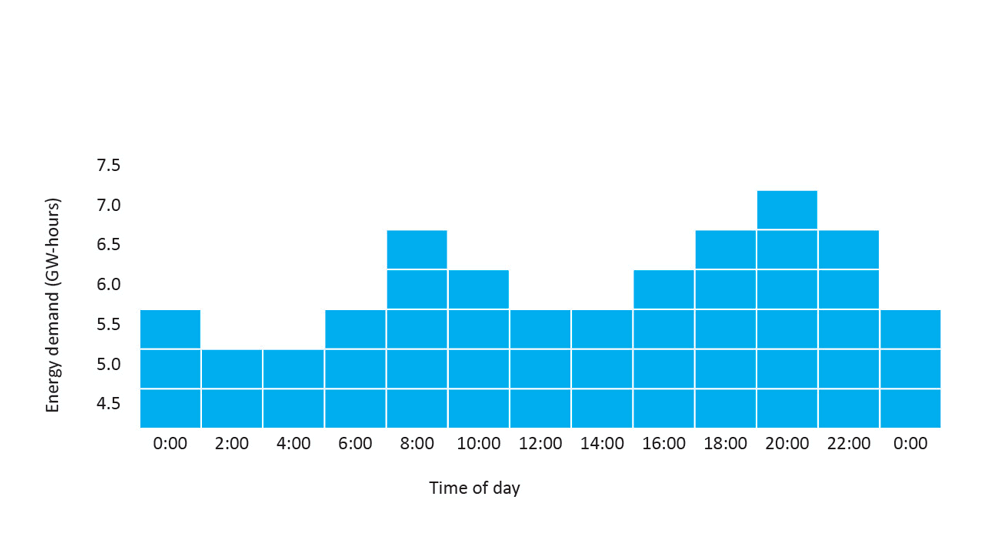
With batteries, we can manage the natural variability of renewable energy sources
With batteries, we can manage the natural variability of renewable energy sources
Energy storage is set to play a crucial role in the structure of Australia’s future electricity grid.
The best-known form of energy storage is batteries. Typically, batteries are used to soak up excess energy to be used later in offsetting supply from centralised generation, at a time when energy is more expensive. For example, you may not need the energy generated by your rooftop solar panels in the middle of the day, so a battery saves that energy for later in the evening instead of drawing from the grid.
A lesser-known role for batteries is delivering power back to the grid – what we call ‘grid services’. These grid services can provide improved power quality, stability and reliability.
Ramp it down with batteries.
Batteries can help minimise the effects of ‘ramping events’, which are large and sudden changes in load and energy generation. This can happen when the sun plays ‘peak-a-boo’ with the clouds and solar energy drops in and out; or the more predictable change that occurs when solar production drops at night. These ramping events can have unwanted effects on voltage and frequency, but batteries can help to make sure these changes are more gradual, which makes it easier to maintain power quality.

emand from power stations in the middle of the day is very low because a lot of the demand is supplied locally by solar panels. But what if batteries charged during this time, and discharged later in the day when demand is high? We would expect the demand from power stations to ‘flatten’ – this avoids (expensive) network infrastructure upgrades to supply the maximum demand.
Managing average daily demand from power stations using batteries (July, 2017)
Managing peak demand
Batteries can also provide energy when demand is expected to peak. During periods of high energy demand (like the middle of summer when air conditioners are running 24/7), the likelihood of that demand exceeding the capability of the network increases. By providing energy close to the expected demand (potentially by discharging batteries), the strain on the electricity network can be reduced – a process known as ‘peak shaving’. This can reduce the costs to maintain the electricity network, as well as our household electricity bills.
Powerful support
Maintaining power quality is important because it allows us to connect almost anything, anytime, without a worry – a mobile phone, a fridge, a TV, even an electric car – as long as it complies with Australian standard voltage and frequency specs.
While renewable energy is cheap and good for the planet, its natural variability makes it harder for our legacy power grids to keep power quality without new support systems. Batteries can very effectively provide such support. By either injecting or absorbing energy at the right times, batteries can maintain power quality, even in grids with large amounts of variable renewable energy supply.
Yarrabilba – leading the charge
In the future, a battery owner could help directly regulate voltage and frequency – that is, provide ‘grid services’ (for an adequate price, of course). As part of our Virtual Power Station trial in Yarrabilba, South East Queensland, we’re testing how to control batteries to manage power quality.
With the cooperation of our Yarrabilba volunteers, we’ve installed five batteries to everyday households. So far we’ve successfully tested their operation, and in the coming weeks we’ll demonstrate that these batteries are capable of mitigating ramping events. With the help of solar forecasting we will regulate solar power in anticipation of a drop in solar energy and simultaneously direct the batteries to discharge stored energy. This helps avoid a large swing in power flow and maintain consistent power quality.


4th May 2018 at 9:06 pm
we intend to install a diesel powered generator 37 kva 3phase and single phase output ,to power our shed . the cost of a 3 phase supply from the grid is too exspensive. we require this size of generator to supply a stable supply for welding operations
we have a 5 kw solar system on the house is it possible to feed excess generator output back to the grid ?
7th May 2018 at 2:26 pm
Hi there, Gerard
You might find the information you’re looking for on this Ausgrid page:
https://www.ausgrid.com.au/Common/Customer-Services/Business-and-commercial/Connecting-to-the-network/How-do-I-connect-to-the-network/Embedded-generation.aspx
Otherwise, they’ve a contact email address you might find helpful.
You can also visit https://www.csiro.au/en/Research/EF for more information on our research.
Thanks very much,
Jesse
Social Media Team
9th March 2018 at 9:29 am
Maurice, living in the rural area of Darwin for 30 years, when questioned where are your solar, panels we can answer, No Sun! our trees completely shade our house and cottage. we could place/fix them on the bitumen road. in Darwin if you are going to remove obstacles/trees over the roof you had better go out and buy another air-conditioner.
8th March 2018 at 3:25 pm
Maurice , I think you’ll find it’s the owners responsibility, or if the tree is not on clients property then you can’t reasonably expect the installer to remove or trim the tree. Also are you wanting Electricians to be trained in Tree Lopping and incurr the cost of a chainsaw’s and the relevant safety equipment , licences and insurances required for this type of work ?
I’m sure the electrician could arrange for a Tree lopper on a subcontracted basis , and pass the bill onto to you Plus his margin , say 25% , or you could just arrange the Tree lopper yourself.
Most designer’s will factor shading in to the performance calculations and advise the client of shading reductions, but the installer may not be the designer , so it’s not his concern or responsibility either. It’s not quite as simple as your comment suggests